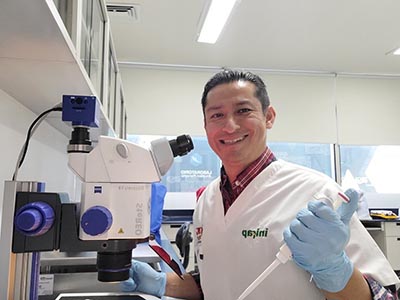Meet Dr. Eliab Estrada-Cortés
Written by Dr. Angela Gonella in Celebration of National Hispanic Heritage Month

The National Hispanic Heritage Month is annually celebrated from September 15 to October 15 in the United States for recognizing the contributions and influence of Latinx to the history, culture, and achievements of the United States. In celebration of Hispanic Heritage Month, Diversity Committee Chair Dr. Angela Gonella sat down with Dr. Eliab Estrada-Cortés from the Experimental Station at the National Institute for Research in Forestry, Agriculture and Livestock (INIFAP, Mexico).
Dr. Estrada-Cortes is developing a research program focused on the epigenetic regulation of preimplantation bovine embryos. The long-term goal of his research program is to gain enough knowledge to use the developmental programming phenomenon as a tool to improve the postnatal health and productive performance of offspring in domestic animals. Furthermore, he is also working on the generation/adaptation of reproductive management strategies to improve performance in small-scale dairy farms and on the improvement of oocyte cryopreservation as part of a program for endangered breeds.
What is your current position, and what does it entail?
Currently, I am a full-time researcher in an Experimental Station at the National Institute for Research in Forestry, Agriculture and Livestock (INIFAP), Ministry of Agriculture and Rural Development in the Mexican Federal Government. Besides my research position, I am a part-time professor at the Veterinary Medicine School of the University of Guadalajara. I teach physiology of reproduction and supervise students in the doctorate of biosciences.
Can you talk a little bit about yourself, where are you from? What first attracted you to the world of science? And how did you get to be in your current position?
I grew up in a small town called Azoyú in Guerrero, Mexico. During my adolescence, I used to help with activities in my family’s cattle operation. Since that time, I have developed a genuine interest in animal production. Due to this, I enrolled in Veterinary Medicine School at Guerrero State University. Throughout my college education, I perceived the reproduction area as an opportunity to improve animal production. I also gained an interest in a scientific and academic career. Therefore, I entered a Master’s Science Program at the National Autonomous University of Mexico (UNAM), where I got a degree in Physiology of Reproduction. Following my long-term professional goal, in 2008, I got a full-time position at INIFAP. Since INIFAP hired me, I have been working in the Dairy Research Program. In 2016, I gained a scholarship from CONACYT (a Mexican government agency that handles scholarships) to pursue my Ph.D. I applied to the Animal Molecular and Cellular Biology Graduate Program of the Department of Animal Sciences at the University of Florida, and I was fortunate to complete my Ph.D. under the supervision of Dr. Peter Hansen in 2021.
What are you most excited to do this year?
Come back to my country to spend time with my family and to try Mexican food after living foreign for several years.
Are there ways in which you think your heritage has affected your perspective or career trajectory?
I do not think so, but we need to keep in mind that societies from different countries or regions have different ways of seeing life than ours. So, sometimes we can misunderstand some behaviors that we think are related to our heritage, but it is not the case. Interaction with our surrounding people and knowing about their cultures is beneficial to deal with this.
What words of inspiration would you like to share with the future generation of scientists, especially those coming from diverse backgrounds?
First, you need to have very clear what are your professional goals and define your passion in this regard. Then choose an area that you enjoy, follow your dreams but set specific goals, always do your best and never give up along the way; this will help you to deal with all challenges that commonly arise through the science path.

